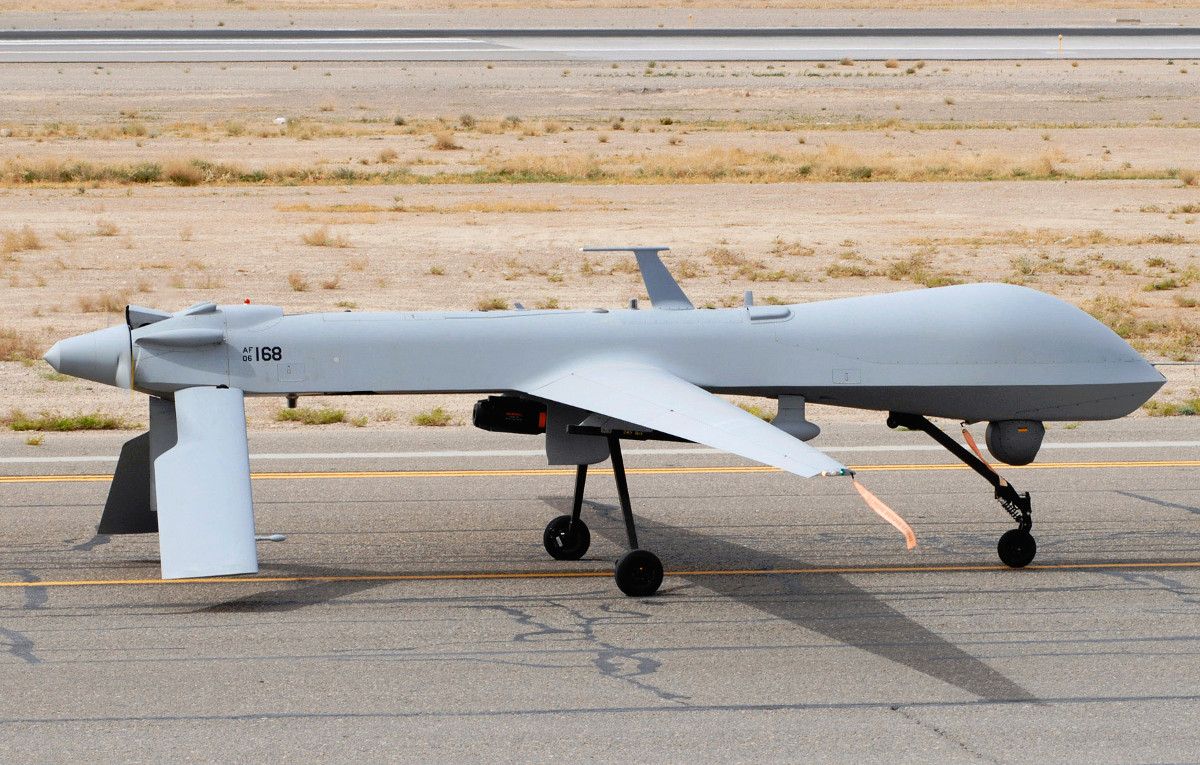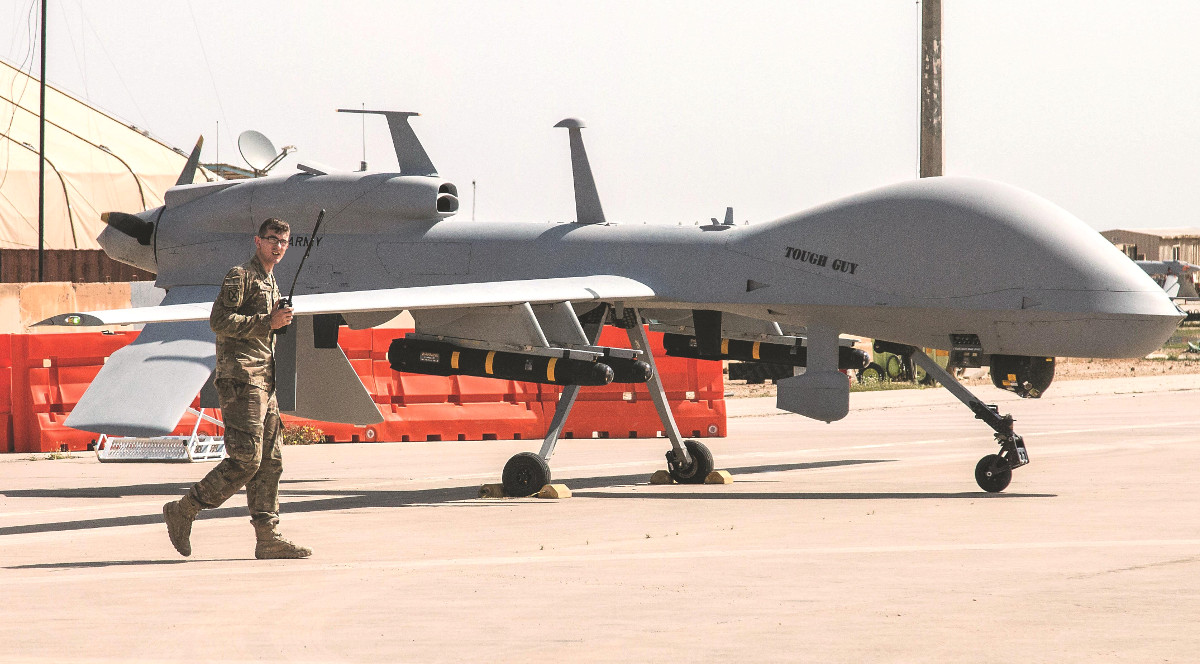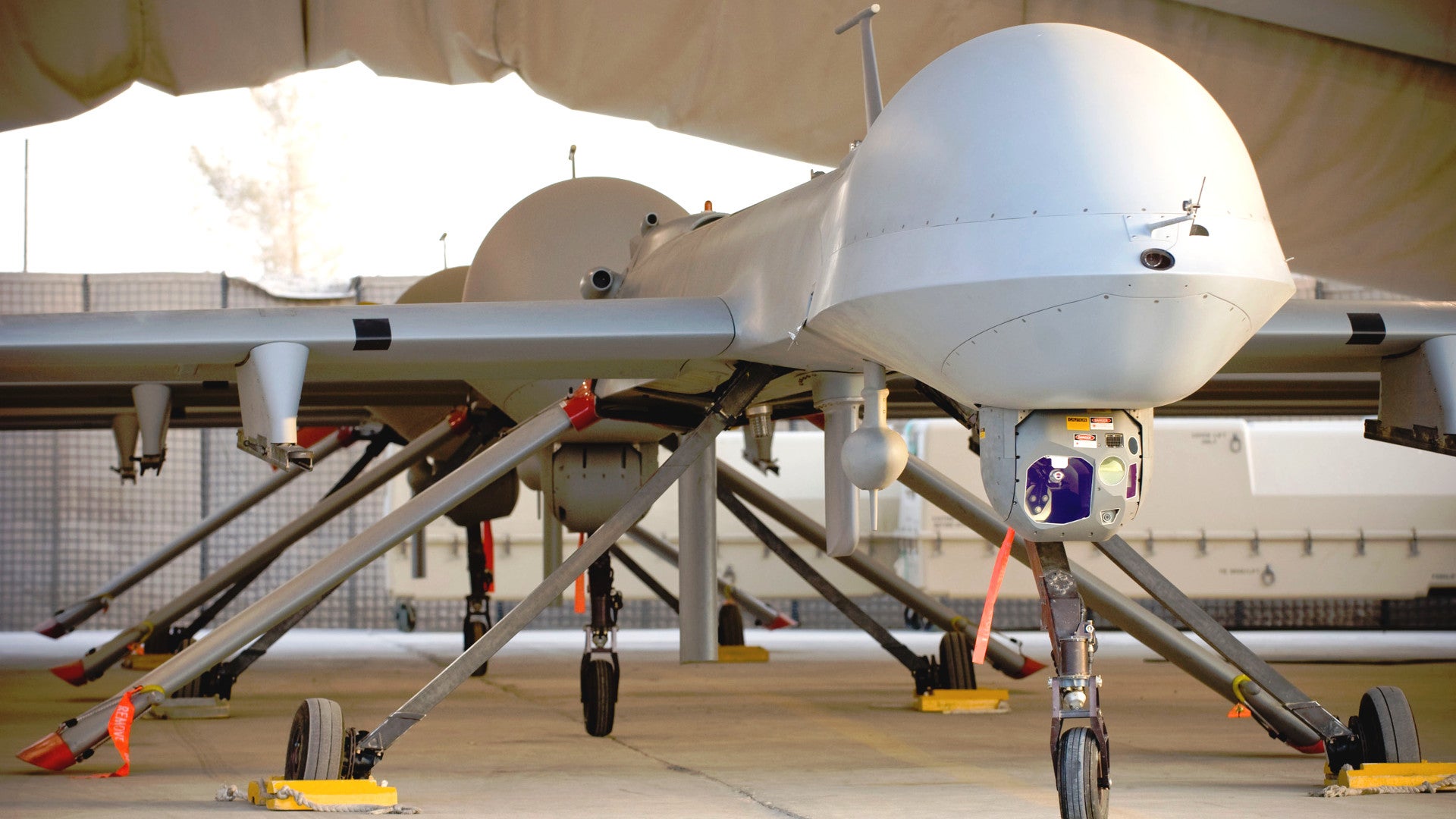After operating the iconic drones for more than two decades of service, the U.S. Air Force is getting closer to retiring its fleet of MQ-1 Predators. The unmanned aircraft may continue to fly at home and abroad, though, with the U.S. Navy looking into picking up some of them before they go to the bone yard.
In an Email to the War Zone, the Air Force confirmed that it expects to complete its planned transition from the MQ-1 to the larger MQ-9 Reaper by the end of 2018. The service first announced that plan in 2015, but without explaining what might happen to the more than 100 remaining perfectly serviceable drones. The first RQ-1 unmanned aircraft entered service with the US Army in 1995 before the Pentagon shifted control to the Air Force in 1996. The type gained the ability to launch AGM-114 Hellfire missiles in 2001 and was re-designated the MQ-1.
“We are in the initial phases of working through the process. There are a number of possibilities as to where they could go, including Air Force museums,” an Air Force spokesperson told us in the Email. “The Air Force is working with the Navy to determine configurations and quantity for possible transfer.”
We don’t know what those configurations would necessarily be or how much of the Predator fleet the Navy might be interested in taking for itself. At present, the Air Force flies the MQ-1 in two primary configurations, with one being setup for armed reconnaissance with two pylons for precision guided bombs or missiles, as well as electro-optical and infrared cameras in a turret under the nose. The service also operates in the drones in an unarmed configuration with just the sensor turret.

The Navy could also replace the existing sensor turret with a newer system, or otherwise look to add in additional sensors or other mission equipment, such as electronic warfare jammers or communications nodes, within the constraints of the design. General Atomics, which developed the Predator, offers the Lynx multi-mode radar with a synthetic aperture imaging capability, which fits in the Army’s similarly sized Warrior Alpha and MQ-1C Gray Eagle drones.
It’s worth noting that the Air Force opted to switch over to the MQ-9 specifically because of its added range and payload capacity and flies Reapers with external fuel tanks in order to further expand its capabilities. At the same time, though, sensor suites for certain mission sets are steadily getting smaller, which might open up new possibilities for the older MQ-1s.
A compact wide-area airborne persistence surveillance system in particular, which feature one or more wide-angle cameras, could breathe more life into the Predators. Various systems exist that would be small enough to fit on the MQ-1, including Logos Technologies Redkite and Elbit Systems SkyEye Wide Area Persistent Surveillance (WAPS).

These sensors can capture still images and full motion video across a broad region, allowing a single unmanned aircraft to monitor a greater area by itself. With this kind of information, intelligence analysts can more readily track enemy movements and spot significant changes in their activities or the terrain itself.
It’s an especially useful capability for locating small groups of fighters who might be operating discreetly across a broad region and then establishing a “pattern of life” to help determine the best possible time to strike. The U.S. military has also found these sensors can help spot improvised explosive devices and then trace militants’ movements back to the workshops where they build the bombs.
The Navy has already made it clear that it is interested in developing its own unmanned airborne surveillance capabilities to support its own personnel, as well as U.S. Marines, during on-going counter-terrorism operations. Earlier in January 2018, the service announced it was interested in hiring General Atomics directly to fly and otherwise maintain its own MQ-9s in Afghanistan.
It is possible that the service could enter into a similar arrangement with General Atomics to operate any MQ-1s it gets second hand from the Air Force. However, the contractors would only be able to fly unarmed reconnaissance missions, at least under existing rules and regulations. The Navy is also responsible for procurement of aircraft for the Marine Corps, so it could acquire the Predators on their behalf.

A fleet of Navy owned and either Navy or Marine operated Predators would be able to conduct both intelligence and surveillance operations, as well as strikes. Either way, the service’s MQ-1s would expand the total number of medium-altitude, medium-endurance drones, which are always in high demand, that are available to the U.S. military as a whole. Other retired airframes could become parts donors to help reduce the cost of sustaining the aircraft.
Whether contractor operated or not, the Navy could assign these drones to conventional units, akin to Navy squadrons with manned patrol aircraft or the Marine Corps’ existing unmanned elements. For the Navy in particular, having the Predators could provide a new stepping stone to a future unmanned combat air vehicle (UCAV) capability, which the service effectively shelved when it decided to turn its carrier-launched stealthy, penetrating strike drone project into a program to develop an unarmed unmanned aerial tanker. Though a future UCAV fleet would be a very different affair from the Predators, including likely flying autonomous or semi-autonomous operations without the need for an operator in the loop, the MQ-1s could serve as a way to steadily integrate armed drones into broader Navy operational concepts and promote the development of more multi-mission unmanned units within the service.
The Naval Special Warfare community itself has long been interested in an organic light attack aircraft to reduce its dependence on other services for this type of support, but has focused primarily and so far unsuccessfully on acquiring a manned type. Of course, Navy and Marine Corps special operations units already have their own drones, but having MQ-1s would provide a very different and proven capability to attack targets, all without having to rely on the U.S. Army and Air Force to provide those assets. This in turn could given those elite Navy and Marine units more flexibility to operate, especially on short notice, when and where the other services might not be available.
Beyond Navy or Marine Corps use, it’s not clear what other future there might be for the Predators, though. The Army has already made it clear that it has no plans to acquire any of the MQ-1s, since they do not share enough components with the MQ-1C for such a plan to make sense logistically. Some could end up as targets for air-to-air and surface-to-air weapons and sensor testing.

Pentagon regulations for this type of military unmanned aircraft technology require thurough de-militarization to remove and destroy components with no defined non-military purpose. This might make it time consuming for the U.S. government to rapidly transfer them to civilian government agencies, such as U.S. Customs and Border Protection or the Drug Enforcement Administration. Still, for those agencies with airborne surveillance requirements it could well be worth going through this process in order to acquire more unmanned aircraft at a relatively low cost.
The rules also ban the sale of any surplus Predators directly to private buyers without going through the aforementioned demilitarization process, though it is possible that the Air Force could cut a deal to send them back to General Atomics. Export restrictions limit the ability of the U.S. government to transfer them to foreign buyers, as well.
“The USAF does not anticipate these aircraft will be made available via the Excess Defense Article Program for Security Cooperation,” the Air Force spokesperson told us specifically in their Email. Still, there will be a “screening of the aircraft condition and configuration to determine if there are suitable candidates to be offered via the Excess Defense Article Program.”

It is possible that this may be less of an issue under President Donald Trump than it might have been in the past, though. The Trump administration has already approved a number of foreign military deals that the U.S. government had previously blocked, including the sales of manned light attack aircraft. In August 2017, the United States launched a review of those export rules with an eye toward to expanding foreign military sales.
In addition, Trump himself has also said he is encouraging the America’s diplomatic corps to push more weapons deals to foreign partners. Loosening up restrictions on the transfer of the Predators could let the U.S. government challenge the growth of similar foreign drone exports, especially from China, to traditional American partners, such as Egypt and Saudi Arabia. MQ-1s could just go to countries that have already secured approval to buy them in the past, such as Italy, Morocco, and the United Arab Emirates.
With the Navy already looking to pick up at least some of the Predators, its likely that the MQ-1’s career with the U.S. military is still far from over.
Contact the author: joe@thedrive.com
